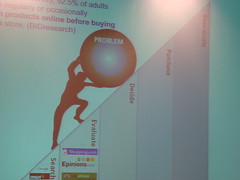Jeffrey and Bryan Eisenberg kicked off the morning with a discussion about how consumers have changed.

Specifically, moving from a push marketing model to a pull in which the audience is engaged in a different way. The audience, which is has historically been bombarded with TV ads, that they either listen to or not, is now interacting with marketing messages in a completely different way.
Gone are the days where folks veg in front of the TV with nothing else going on around them. (for most people :))
A study by Yahoo! Global Market Research study (2006) showed that individuals rarely watch TV as a standalone activity.
Rather, they are dividing time between TV and other activities.
60% Web surfing
51% Talking on the phone
59% Reading
43% Cleaning
40% Sleeping
37% Cooking
While multitasking, the audience is exposed to TV messages that they may/may not pay attention to. However, in terms of online marketing the click is always as a conscious choice.
Because it is a conscious choice, we need to market differently pulling to consumer to the information.
Eisenberg presented 4 new customer definitions that we should be paying attention to including:
1. We are all connected, want to participate in conversation and communicate faster than ever before
Email, blogs, instant messaging etc has created a real-time word of mouth network between connected individuals. Because of this connection bad brand experiences have catapulted to the mainstream (think Dell) and created an atmosphere of distrust in marketing messages.
The ability of the individual to communicate information to the masses has made it impossible for big brands to continue making promises they can’t keep.
While it’s good for consumers, it’s not so good for marketers because the messages we are disseminating aren’t wanted and aren’t trusted.
A study conducted by Edelman confirms this:
Consumers trust in a ‘person like me’ increased from 20% to 68% from 2003 to 2006.
In addition, of consumers:
54% resist marketing messages
56% avoid marketing messages
69% proactively block marketing messages
So what’s a marketer to do? The first step is to stop ‘thinking’ we know what our target audience is doing/feeling/wanting and start to understand them. How can we market appropriately to someone we don’t understand?
Essentially we’re talking about relevancy. If we give the consumer the information they want, when they want it and how they want it the product/service should really sell itself.
2. Customers will control the conversation
Eisenberg spoke to the buying process and viewing it as a customer journey. Not only are customers controlling the conversations around brands, products and purchases they are also in charge of the actions they take.
The customer is not a Pavlov dog and isn’t responding just because a marketer rings a bell.
Customer’s today are using the following journey when making a purchase:
Search – Researching what they are interested in via the search engines
Evaluate – Asking friends, evaluating pros/cons and paying attention to user reviews
Decide – Deciding what they want to buy
Purchase – Actually buying what they decided to buy
Reevaluate – Evaluating the product/service after purchase and deeming it a good/bad purchase thereafter
The sad story is that most websites are not built to help people find what they are looking for AND give enough information so that they will feel confident enough to make a purchase.
3. Customers desire meaning and relevant experiences. Your actions matter, your words less
67% of consumers who visited an online store intending to make a purchase left because the retailer did not provide enough information. Future Now Inc Study
This is because the majority of websites are missing the basic fundamentals of what consumers want to know/need to have before making a purchase.
Also, from the study:
61% do not offer any info on the product page regarding in-stock availability
38% of sites have difficult to read fonts
–only 14% allow customers to change the font size
24% do not allow customers to enlarge the product image
Only 42% provide shipping cost early in the checkout process
–42% provide shipping cost early in the checkout process
Only 37% offer multiple image views of products
Only 33% offer customer reviews
I’m not surprised by the stats above having muddled my way through enough websites wondering why a company makes it so difficult to buy its product/engage in its services.
However, I am curious how long this trend will continue. Customers are telling us, both verbally and via abandonment rates, that the sites we build FOR THEM are insufficient.
Yet companies continue to keep building websites leveraging similar formats/content as the previous ones, deciding to update the look and tweak very few items in terms of functionality.
While I enjoy aesthetically pleasing websites as much as anyone else at the end of the day I visit websites with an INTENTION. I want to buy something, I need information, etc.
If the website makes it more difficult for me to make a purchase, you can bet I’m leaving and doing one of two things:
1. Going to the competitors’ website
2. Going to the brick and mortar to buy
4. Customers are in control of their buying process; this doesn’t mean they are engaged in your sales process
While I think this speaks to the information in #3, it may be important to break it out just for reiteration purposes.
At the end of the day, the consumer decides what to purchase, when to purchase, how much he/she is willing to spend on the purchase. If this process happens to fit into a narrowly defined sales funnel, then great!
When it doesn’t are we adequately capturing the information? I don’t think so. I believe that too many actions in a sales funnel that are coincidence are taken as correlations.
That said, it can be fixed by understanding what the customer’s buying process IS and catering to it, instead of defining the sales funnel and trying to fit customer behaviors into our models.
That said, this was a fantastic session which gave attendees much to think about bright and early on a Monday morning. More to come later regarding persuading consumers, once we have given them the information they require!
Be sure to visit TopRank’s Flickr set for SES New York Photos, updated every few hours.



